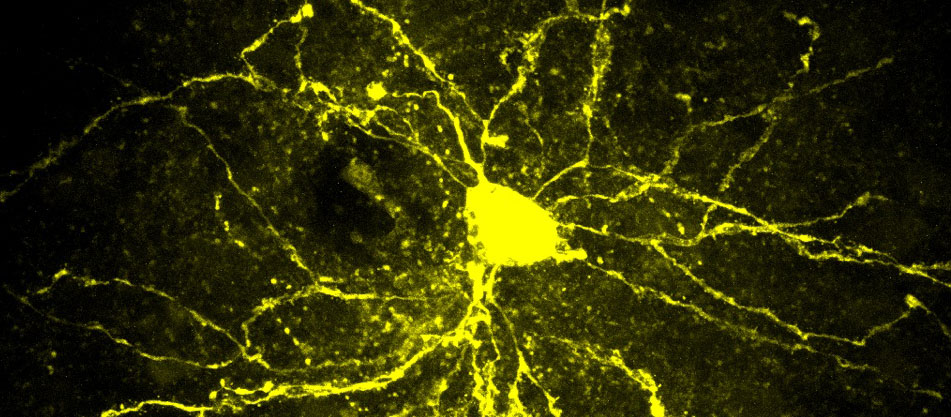Gene-environment interactions that drives autism
A UNIGE team demonstrates how genes and environment interact in autistic disorders, thus explaining the vast variability of the disease’s symptoms.

Medium Spiny Neuron located in the nucleus accumbens, one of the neural networks of the reward system. (c) Camilla Bellone - UNIGE
People with autism spectrum disorders all have characteristic behavioural difficulties. Nevertheless, the important heterogeneity of their symptoms remains one of the major questions for scientists and physicians. While a link between the inflammatory process and autism was suspected, a team from the University of Geneva (UNIGE), Switzerland, within the framework of the Synapsy National Centre of Competence in Research, has for the first time deciphered how a change in cell environment triggers the onset of autistic symptoms in mice with a genetic vulnerability. Indeed, an imbalance in the expression of a series of genes caused by a massive inflammation — resulting from an immune response to the administration of a pharmacological product —leads to the hyperexcitability of neurons of the reward system. These results, to be read in the journal Molecular Psychiatry, provide the first evidence of the close interactions between genes and the environment in the social dysfunctions typical of autistic disorders.
The research team led by Camilla Bellone, a professor in the Department of Basic Neurosciences at the UNIGE Faculty of Medicine and director of the Synapsy National Centre of Competence in Research, had already demonstrated the role of the reward system in the social interaction deficit in autistic mice. Indeed, the motivation that drives individuals to interact with their peers is closely linked to the reward system, through the activation of the neuronal networks that make it up.
But what are the cellular and molecular mechanisms at the origin of the deficits in social interaction? To understand this process and thus decipher how the symptoms appear, the scientists studied so-called heterozygous mice, i.e. mice carrying a deletion of only one of the two copies of the SHANK3 gene, but not showing social behavioural disorders. With 1-2% of all autism cases, this is indeed one of the most common monogenic causes of the disease.
“Humans carry a mutation in only one of the two copies of SHANK3, a gene that is essential for the functioning of synapses and communication between neurons,” points out Camilla Bellone. “In animal models of the disease, however, mutation of a single copy of SHANK3 only slightly affects the behaviour of mice, which explains why the behavioural phenotypes observed are not homogeneous”.
The role of neuronal hyperexcitability
The researchers first inhibited the expression of SHANK3 in the neural networks of the reward system in order to identify the other genes whose expression was modified. Several genes related to the inflammatory system were detected, including one of them, Trpv4, which is also involved in the functioning of communication channels between neurons. “By inducing massive inflammation, we observed an overexpression of Trpv4, which then led to a neuronal hyperexcitability concomitant to the onset of social avoidance behaviours that our mice did not exhibit until now,” stresses Camilla Bellone. Moreover, by inhibiting Trpv4, the scientists were able to restore normal social behaviour.
“This provides evidence that autistic disorders are indeed the result of an interaction between a genetic susceptibility and an external trigger - in this case, massive inflammation. Neuronal hyperexcitability disrupts communication channels, thereby altering the brain circuits governing social behaviour.” This would also explain why the same genetic predisposition can lead, depending on the environmental factors encountered and the type of inflammation they trigger, to a diversity of symptoms of equally variable severity.
Irreversible damage during development?
In this study, the inflammation was induced in adult animals. The resulting deficit in social behaviour was not only reversible, but also disappeared naturally after a few days. “We now need to replicate our research during the critical phases of neurodevelopment — i.e. during gestation and immediately after birth — in order to observe the impact of hyperexcitability on the developing neural networks. This could damage the construction of neural networks beyond repairs,” says Camilla Bellone.
This study constitutes a proof-of-principle of a direct causality between inflammation and the appearance of behavioural symptoms in the presence of genetic vulnerability, and highlights the importance of environmental factors, which have been largely underestimated until now. It also highlights the fact that the understanding of the mechanisms behind autistic disorders still needs to be refined in order to intervene effectively. Indeed, depending on the gene-environment interactions and inflammatory mechanisms specific to each patient, it would be possible to identify a treatment that would correspond exactly to the cellular and molecular modification at stake in the brain circuits.
31 Jan 2022